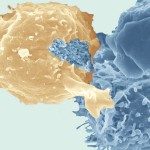Link to Pubmed [PMID] – 28060812
PLoS Negl Trop Dis 2017 Jan;11(1):e0005278
BACKGROUND: Human T-Lymphotropic Virus type 1 (HTLV-1) is endemic among people of Melanesian descent in Papua New Guinea, Solomon Islands and Vanuatu, and in Indigenous populations from Central Australia. Molecular studies revealed that these Australo-Melanesian strains constitute the highly divergent HTLV-1c subtype. New Caledonia is a French overseas territory located in the Southwest Pacific Ocean. HTLV-1 situation is poorly documented in New Caledonia and the molecular epidemiology of HTLV-1 infection remains unknown.
OBJECTIVES: Studying 500 older adults Melanesian natives from New Caledonia, we aim to evaluate the HTLV-1 seroprevalence and to molecularly characterize HTLV-1 proviral strains.
STUDY DESIGN: Plasma from 262 men and 238 females (age range: 60-96 years old, mean age: 70.5) were screened for anti-HTLV-1 antibodies by particle agglutination (PA) and indirect immunofluorescence assay (IFA). Serological confirmation was obtained using Western blot assay. DNAs were extracted from peripheral blood buffy coat of HTLV-1 seropositive individuals, and subjected to four series of PCR (LTR-gag; pro-pol; pol-env and tax-LTR). Primers were designed from highly common conserved regions of the major HTLV-1 subtypes to characterize the entire HTLV-1 proviral genome.
RESULTS: Among 500 samples, 3 were PA and IFA positive. The overall seroprevalence was 0.6%. The DNA sample from 1 New Caledonian woman (NCP201) was found positive by PCR and the complete HTLV-1 proviral genome (9,033-bp) was obtained. The full-length HTLV-1 genomic sequence from a native woman from Vanuatu (EM5), obtained in the frame of our previous studies, was also characterized. Both sequences belonged to the HTLV-1c Australo-Melanesian subtype. The NCP201 strain exhibited 0.3% nucleotide divergence with the EM5 strain from Vanuatu. Furthermore, divergence reached 1.1% to 2.9% with the Solomon and Australian sequences respectively. Phylogenetic analyses on a 522-bp-long fragment of the gp21-env gene showed the existence of two major clades. The first is composed of strains from Papua New Guinea; the second includes strains from all neighboring archipelagos (Solomon, Vanuatu, New Caledonia), and Australia. Interestingly, this second clade itself is divided into two sub-clades: strains from Australia on one hand, and strains from Solomon Islands, Vanuatu and New Caledonia on the other hand.
CONCLUSIONS: The HTLV-1 seroprevalence (0.6%) in the studied adult population from New Caledonia appears to be low. This seroprevalence is quite similar to the situation observed in Vanuatu and Solomon Islands. However it is very different to the one encountered in Central Australia. Taken together, these results demonstrated that Australo-Melanesia is endemic for HTLV-1 infection with a high diversity of HTLV-1c strains and a clear geographic clustering according to the island of origin of HTLV-1 infected persons.

